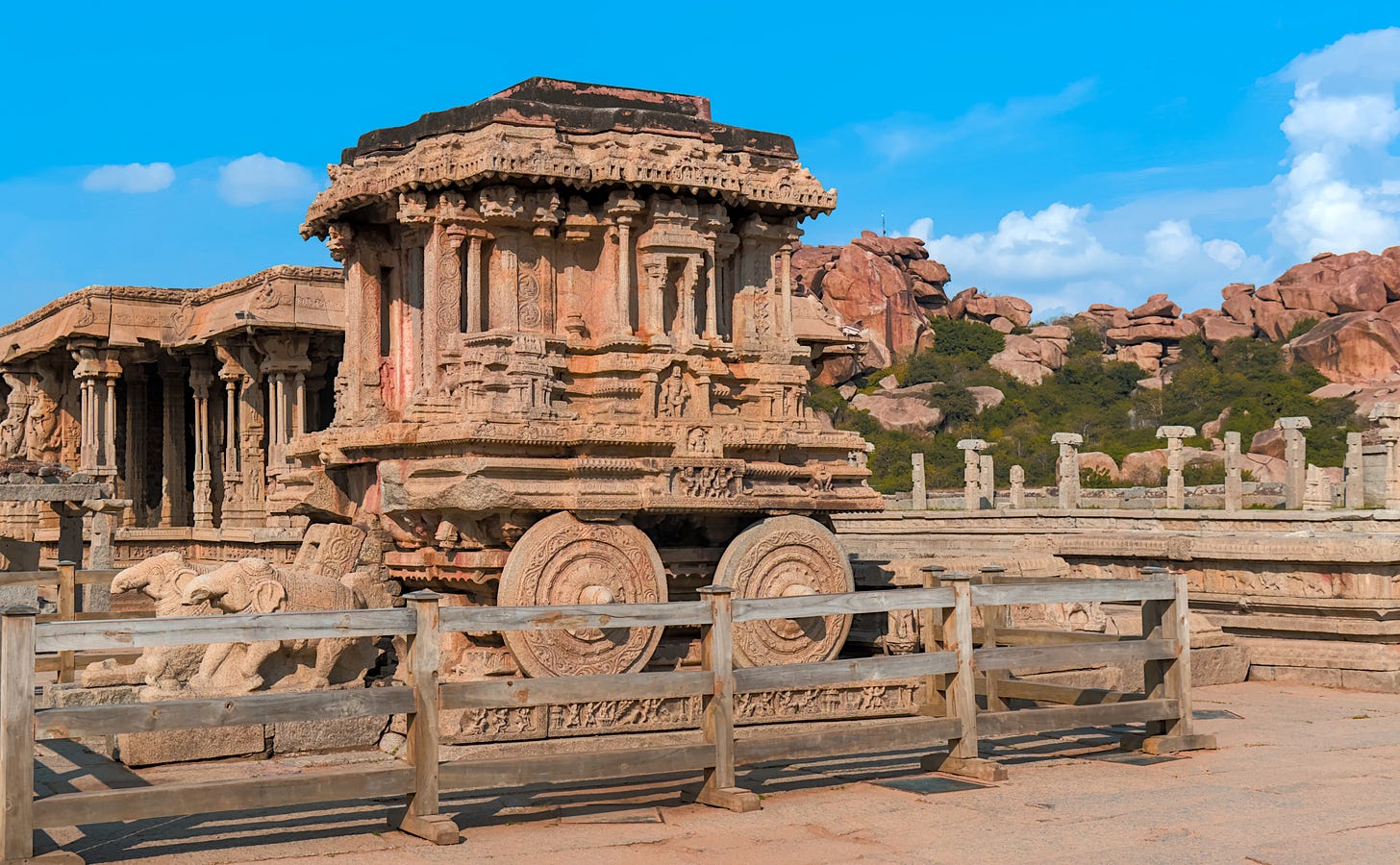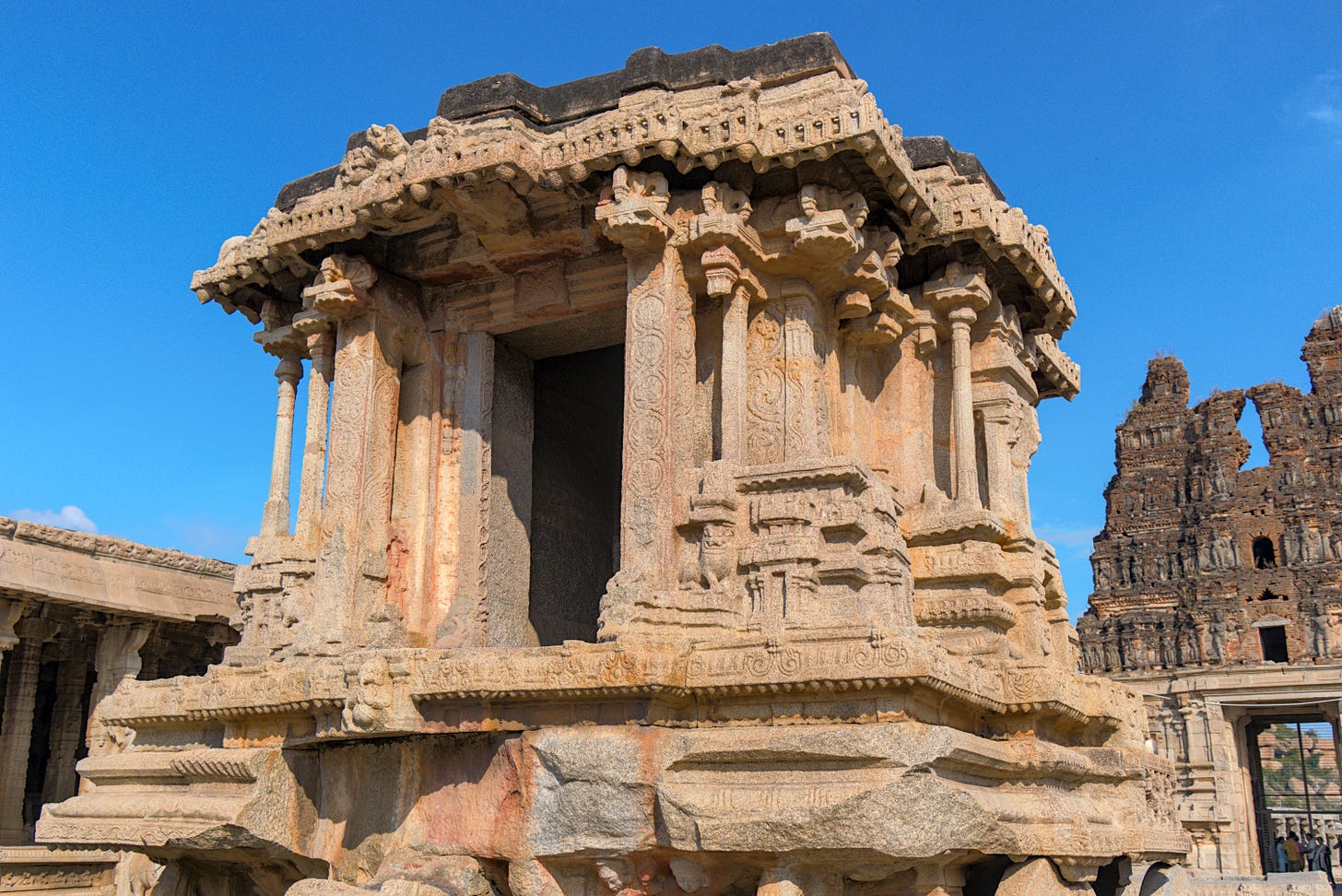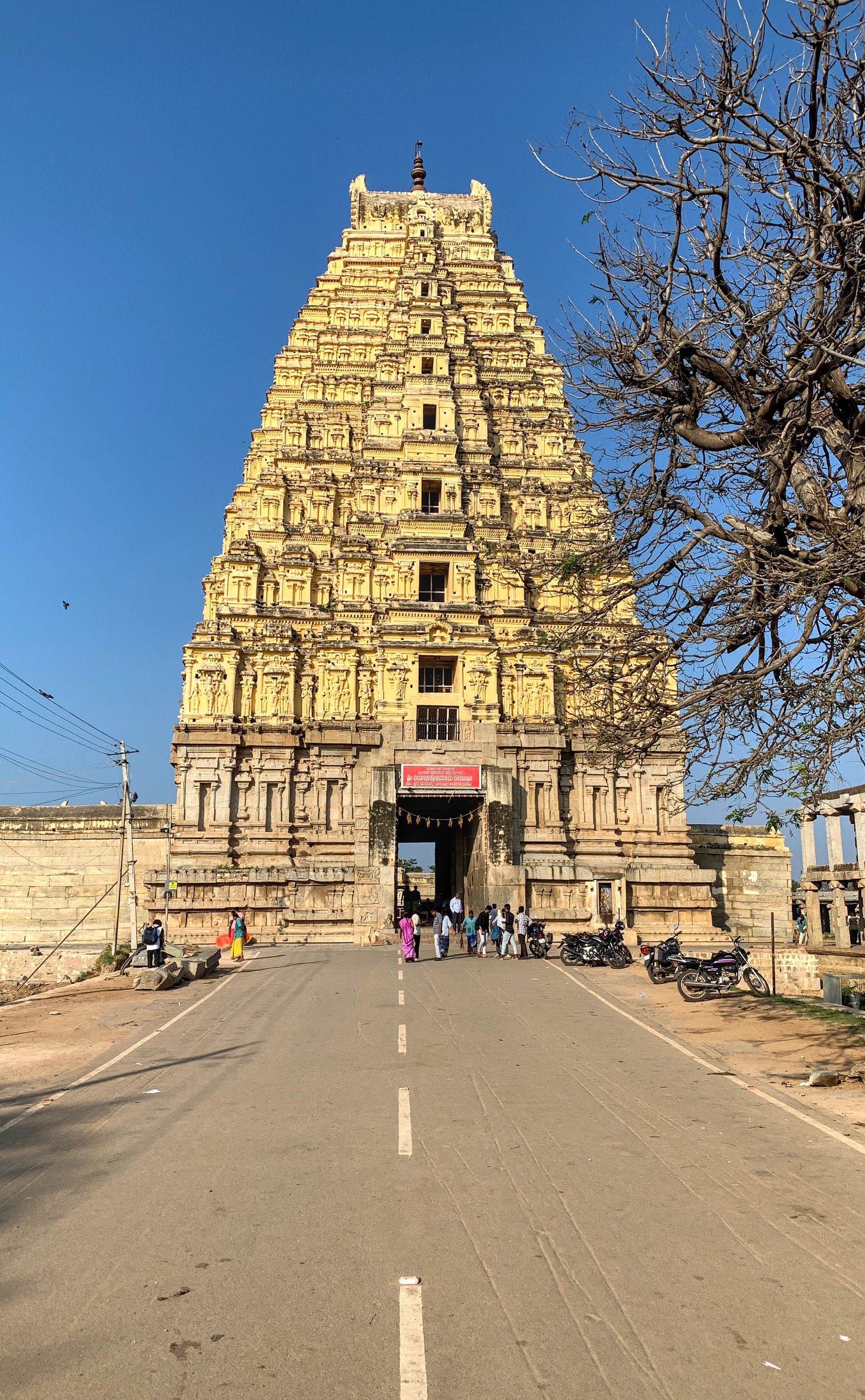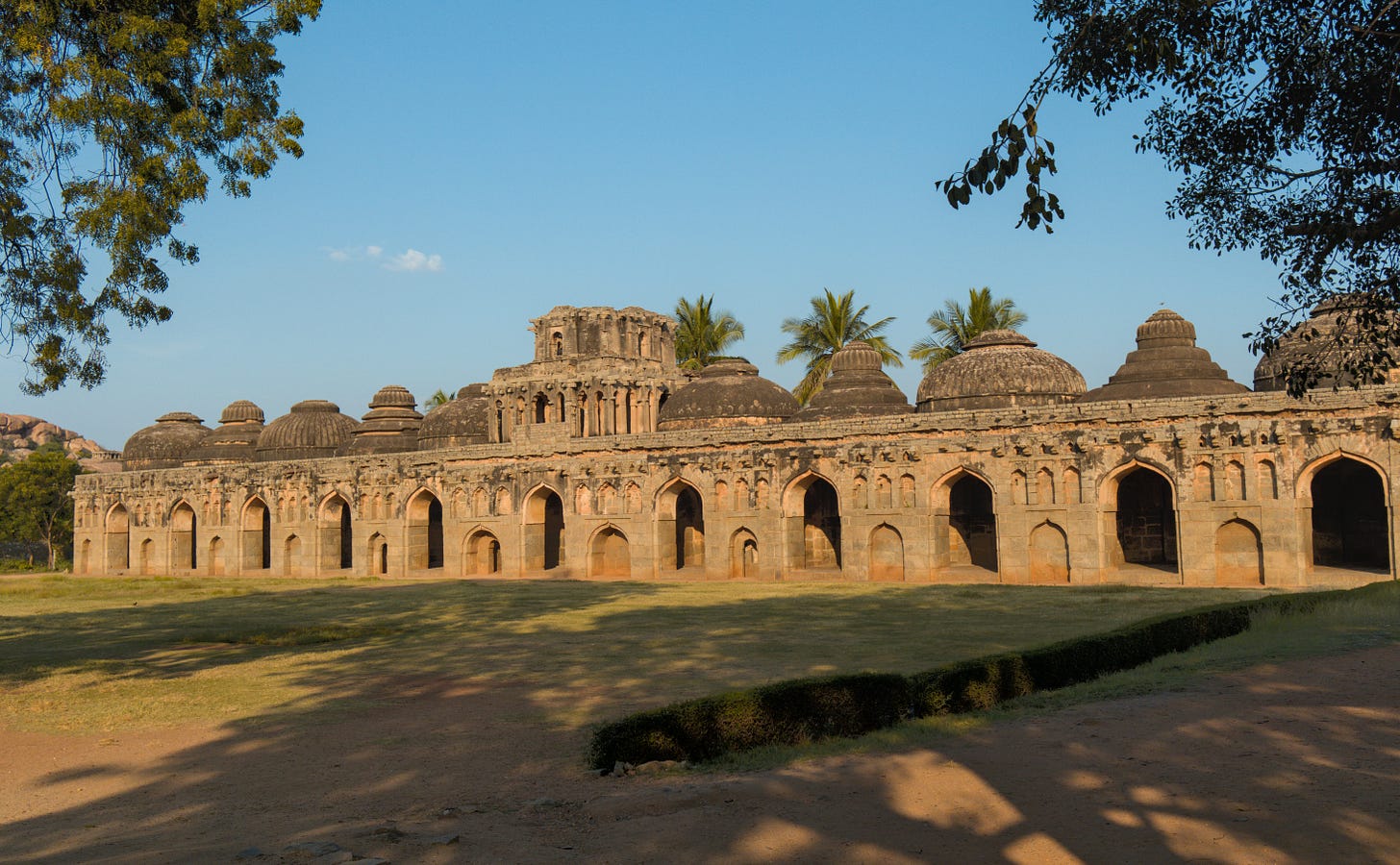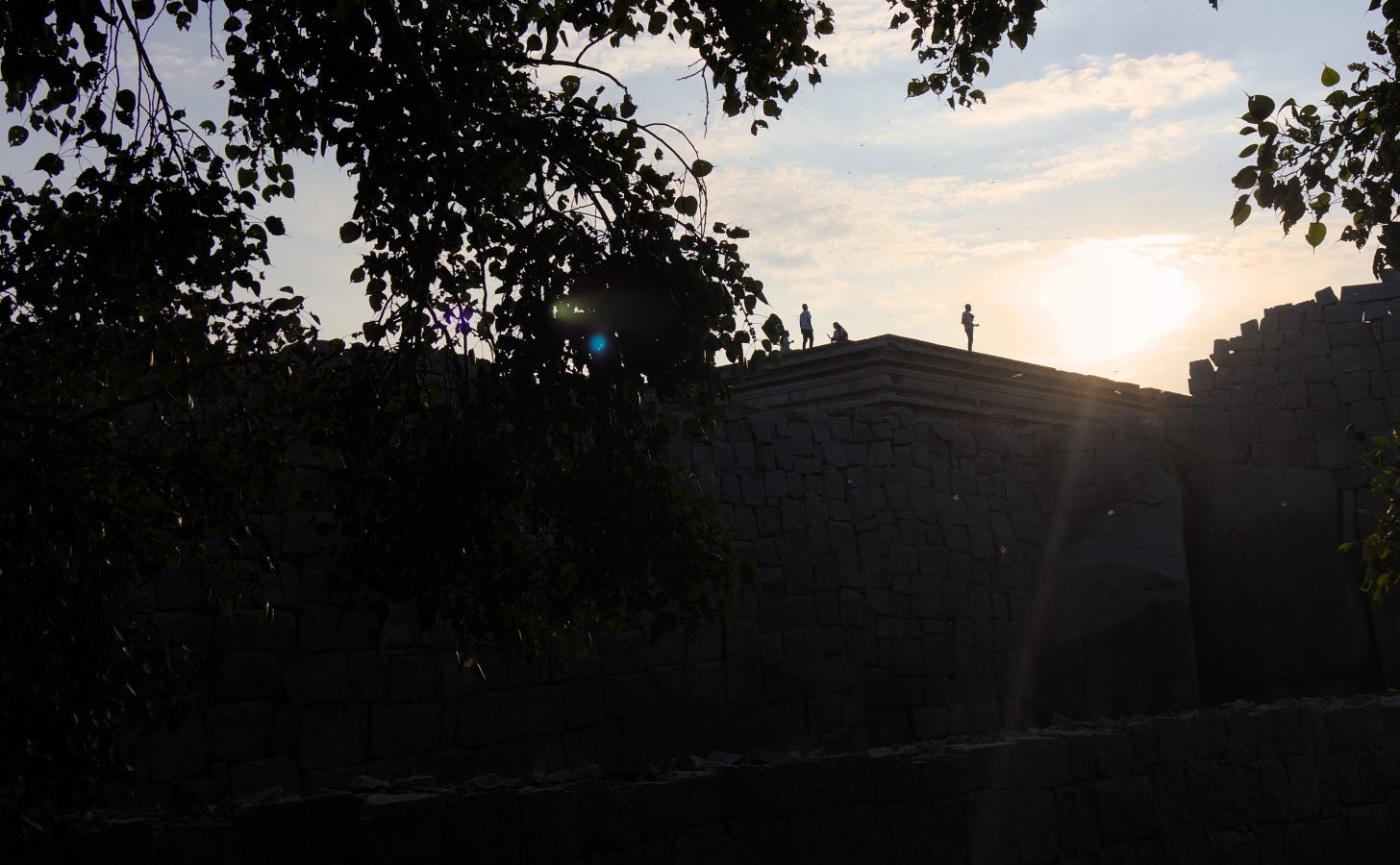Discover Hampi: The ultimate travel guide to exploring its top Temples and Monuments
A journey to the marvelous UNESCO World heritage site
Why you should visit Hampi
Over 500 years ago, there was a city in India that flourished with immense wealth and prosperity. Hampi, then known as Vijayanagara, was the capital of the mighty Vijayanagara Empire and was considered one of the richest cities of its time. At its peak, it was the second-largest city in the world, drawing traders and travelers from across the globe. Under the reign of the Vijayanagara kings, the city became home to breathtaking rock-cut temples and magnificent palaces, showcasing the architectural brilliance of the era. Situated along the banks of the Tungabhadra River, Hampi was a dream city, embodying the grandeur and ambition of a golden age.
Spread across a vast 4,000 acres of land, Hampi still stands tall today with its awe-inspiring ruins. As a UNESCO World Heritage site, it attracts millions of travelers from all corners of the globe. Backpackers, historians, and adventure enthusiasts come to Hampi to experience its majestic past. The towering clusters of boulders surrounding the city continue to amaze visitors.
It’s impossible not to be captivated by the stunning architecture and intricate carvings found in Hampi’s rock-cut temples. The way stories from the Ramayana and tales of triumph over enemies are skillfully portrayed on the temple walls is simply breathtaking.
Whether you're a mountain lover, a beach enthusiast, or a spiritual traveler, and regardless of your age or travel preferences, Hampi offers an experience that should not be missed in a lifetime!
Vijayanagara empire History
Without some prior knowledge or context, you may not be able to fully appreciate your journey to this historical masterpiece. Let’s take a look at the basic history of the Vijayanagara Empire.
The Vijayanagara Empire was founded by two brothers, Harihara I and Bukka Raya I, around the 14th century. It is believed that they were commanders in the Hoysala army and were tasked with resisting invasions from northern India. As the Hoysala Empire declined, the two brothers established a new kingdom on the banks of the Tungabhadra River.
The Vijayanagara Empire flourished under the rule of several kings between the 14th and 16th centuries, but it reached its peak during the reign of king Krishnadevaraya.
King Krishnadevaraya won numerous difficult wars, expanding the empire's territory exponentially. During his reign, he also constructed many magnificent temples and monuments. Krishnadevaraya carefully planned and enhanced the city of Vijayanagara in various ways, including the construction of markets around major temples to attract traders from all over the world.
After Krishnadevaraya, the empire was succeeded by Achyuta Deva Raya, followed by several other rulers until the eventual decline of the Vijayanagara Empire.
Don't forget to visit the museum in Hampi to dive deeper into the history of the Vijayanagara Empire, its rulers, and many other important historical details.
How many days are required for Hampi exploration?
Hampi spans across many kilometers and is home to over 20 significant monuments. These cannot be explored in just a day or two. Even with a tight schedule, at least three days are needed to explore the major monuments of Hampi.
Hampi is divided into two parts by the Tungabhadra River: Southern Hampi and Northern Hampi. The majority of the temples and monuments are located in Southern Hampi, which is further divided into several clusters. With a good plan, these can be explored in about two days. Northern Hampi, while equally beautiful, requires a full day for exploration.
You can either book a cab or auto for the entire day, or split your itinerary into morning and evening visits to avoid the afternoon heat. We purposely chose the latter, visiting only in the morning and evening, allowing us to leisurely explore the monuments without a hectic schedule.
Make sure to negotiate the fare with the auto or cab driver!
Major temples and monuments
Let’s dive into a few of the major sites of Southern Hampi in this blog. We can cover the other monuments along with the glimpse on Northern Hampi in the next blog.
Vijaya Vittala Temple
The Vijaya Vittala Temple, one of the most ionic monuments in Hampi. It attracts tourists for a variety of reasons, most notably its astonishing architecture. The temple complex is one of the largest among all the monuments in Hampi.
Upon entering the temple, you’ll immediately be drawn to the famous Stone Chariot, which is a must-see for visitors. It is a perfect spot for a memorable selfie.
Another major attraction within the temple complex is the Musical Pillars, which, when tapped, produce a range of musical notes. However, as of now, tourists are not permitted to enter this part of the temple.
The temple complex is situated quite a distance from the ticket counter. To reach it, visitors can opt for battery-operated vehicles for a nominal fee, as private vehicles are not permitted. Keep in mind that during peak seasons, especially on weekends, long queues for these vehicles are common. If you prefer, you can also take a scenic walk of about 20 to 30 minutes to reach the temple.
Virupaksha Temple
Among the few active temples in Hampi, Virupaksha Temple stands out as one of the most popular in the region. It attracts tourists and devotees from around the world. Remarkably, the temple has remained largely untouched by the destruction faced by many other structures of the Vijayanagara Empire. Dedicated to Lord Shiva, the temple is locally known as Virupaksha or Pampa Pathi.
Due to its importance as a pilgrimage site, Virupaksha Temple is consistently crowded throughout the year. To bypass the regular queues, visitors can purchase a ticket for direct access to the main temple. Don't forget to seek blessings from Laxmi, the famous temple elephant, a beloved figure among devotees.
While exploring the temple complex, be cautious of the monkeys, as they are quite active and may attempt to snatch food from visitors.
Hazara Rama Temple
Located in the heart of the royal enclosure, the Hazara Rama Temple is dedicated to Lord Rama. It once served as the private temple of the king's family. Though relatively small in size, the temple is renowned for its stunning beauty. Intricate sculptures and beautiful paintings inside the temple complex are unforgettable. Detailed carvings on the walls of the temple depict various stories from the Ramayana, making it a significant cultural landmark.
Achyutaraya temple
If you enjoy hiking and a bit of adventure, don’t miss a visit to the Achyutaraya Temple. Located near the Virupaksha Temple, reaching the temple requires climbing numerous steep steps. The walk to the temple is scenic, offering beautiful views, but it will certainly test your endurance. As one of the quieter monuments in Hampi, it offers a peaceful atmosphere, making it a perfect spot to explore and soak in the surroundings.
Lotus Mahal
The Lotus Mahal is one of the finest examples of architectural design in Hampi, making it a perfect spot for photography enthusiasts. It is located within the Zenana Enclosure, which was once reserved specifically for royal women. It remains largely untouched by the damages inflicted by past invaders.
Elephant Stable
The Elephant Stable is one of the most unique and impressive structures from the royal era, once used as shelter for the royal elephants of the Vijayanagara Empire. Located near the Lotus Mahal, it is a must-visit site in Hampi, offering a glimpse into the grandeur and royal glory of the empire.
Mahanavami Dibba
One of the tallest structures in Hampi, Mahanavami Dibba is located within the Royal Enclosure. Also known as Dasara Dibba, it was built during the reign of King Krishnadevaraya. This platform served as the center for celebrating the Dasara festival during that era.
To reach the top of Mahanavami Dibba, visitors need to climb a few steep steps. Once at the top, you'll be rewarded with a stunning view of the surrounding area.
Best time to visit Hampi
Hampi experiences a dry climate for most of the year, with extremely hot summers. The best time to visit is after the monsoon, from October to February, when the weather is more pleasant.
If you're planning to visit during the summer months, it’s advisable to avoid the afternoon heat. Instead, limit your sightseeing to the early morning or late evening hours when the temperatures are more bearable.
Few more important things to know before visiting Hampi
It is advisable to visit the Archaeological Museum to learn about the history of the Vijayanagara Empire.
As a UNESCO World Heritage Site, most monuments follow strict timings, generally between 9 AM to 5:30 PM.
Be sure to carry plenty of water during sightseeing, due to the hot and dry weather in Hampi.
Some places, like Matanga Hill, offer beautiful sunset views, but reaching the top will test your endurance
You can stay either near Hospet Railway Station, in homestays close to Hampi, or in the Kamalapura area.
There are plenty of budget-friendly and luxury hotels near Hospet Railway Station, ideal for couples and families.
Homestays near Hampi are mostly suited for backpackers or groups of young travelers.
Although Kamalapura is very close to Hampi, there are limited accommodation options in the area.
Local food at small shops or hotels near Hampi is delicious and should definitely be tried during your stay.
How to reach Hampi
By Air: Hampi does not have its own airport. The nearest airport is in Hubli, approximately 170 km away. You can hire a cab from the airport to reach Hampi, with the drive typically taking around 3.5 to 4 hours.
By Train: The nearest railway station to Hampi is Hospet Railway Station, which is well-connected to major cities in Karnataka and nearby states. It is approximately 14 km from Hampi.
By Road: As a popular tourist destination in Karnataka, Hampi is well-connected by road. Both private and state-run buses run frequently from nearby cities like Hubli, Badami and others.




